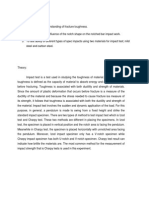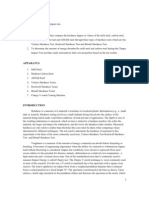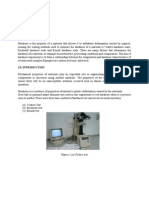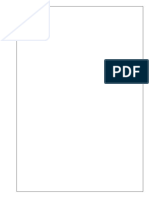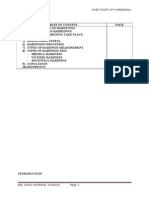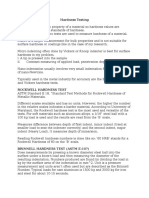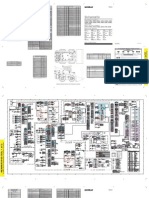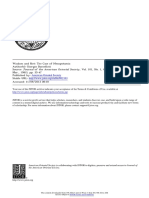Hardness Test Unfinished
Hardness Test Unfinished
Uploaded by
Tidur CukupCopyright:
Available Formats
Hardness Test Unfinished
Hardness Test Unfinished
Uploaded by
Tidur CukupCopyright
Available Formats
Share this document
Did you find this document useful?
Is this content inappropriate?
Copyright:
Available Formats
Hardness Test Unfinished
Hardness Test Unfinished
Uploaded by
Tidur CukupCopyright:
Available Formats
TENGKU MUHAMMAD IBRAHIM SALAHUDDIN BIN TENGKU AHMAD KEM110056
HARDNESS TEST
UNIVERSITI MALAYA LAPORAN MAKMAL TAHUN SATU SESI 2011/2012
TAJUK UJIKAJI: HARDNESS TEST
NO. K. MATRIK: KEM110056 NAMA: TENGKU MUHAMMAD IBRAHIM SALAHUDDIN BIN TENGKU AHMAD SUBJEK: BASIC MATERIAL SCIENCE
TENGKU MUHAMMAD IBRAHIM SALAHUDDIN BIN TENGKU AHMAD KEM110056
HARDNESS TEST
Title:
Hardness Test
Objective:
To compare the hardness of different material ( steel ; which is ASSAB, carbon steel and mild steel)
Abstract:
Objective of this experiment is to determine the hardness of the material. The Hardness test is divided into three different types of test, which are Vickers hardness test, Rockwell hardness test, Brinell hardness test and Charpy Impact test. In Vickers hardness test, Mild steel and carbon steel are being tested. Same for Rockwell hardness test and Brinell hardness test, the steel used is tested by impact load. But the scale of the force used and the technic is varied with one another. Introduction: Hardness is the measure of solid matter resistance to various kinds of permanent shape change when a force is applied (http://en.wikipedia.org/wiki/Hardness), Resistance of metal to plastic deformation, usually by indentation (The Metals Handbook). Hardness is also defined as a obstruction material for concavity material. In this experiment, we are going to test the hardness of the metals by using several methods, which are Vicker Hardness Test, Rockwell Hardness Test, Brinell Hardness Test and Charpy Impact test. Vickers Hardness Test The Vickers hardness test method consists of indenting the test material with a diamond indenter, in the form of a right pyramid with a square base and an angle of 136 degrees between opposite faces subjected to a load of 5 to 120 kgf. The full load is normally applied for 15 seconds. The two diagonals of the indentation left in the surface of the material after removal of the load are measured using a microscope and their average calculated. The area of the sloping surface of the indentation is calculated. The Vickers hardness is the quotient obtained by dividing the kgf load by the square mm area of indentation.
TENGKU MUHAMMAD IBRAHIM SALAHUDDIN BIN TENGKU AHMAD KEM110056
HARDNESS TEST
F= Load in kgf
d=
HV = Vickers hardness HV=
= 1.854
(estimated)
Rockwell hardness test By using scale C , concavity is a cone diamond with load of 150 kgf. The full load is normally applied for 15 seconds. Firstly , small load is use and change to zero. Then additional load is added to get some concavity, d. Then Rockwell hardness is calculated by equation :
Where, d=concavity Brinell hardness test From Brinell hardness test, the harden steel ball with diameter, D under the load of 1000kgf within 15 second will be use to get the concavity effect, d. Brinell hardness number (BHN) is calculated by equation :
TENGKU MUHAMMAD IBRAHIM SALAHUDDIN BIN TENGKU AHMAD KEM110056
HARDNESS TEST
Experimental Procedure: Vickers Hardness Test 1) The specimen (mild steel) is correctly place on anvil of the Vickers Hardness instrument. 2) The specimen is being focused and changed it below the indenter exactly. 3) The START button is pressed and the machine will shine with the sound showed that the machine is readily operated. 4) When the START light goes off, the indenter is assured that it doesnt touches the specimens surface. 5) Change the indenter with the lens. 6) The width of the corner is measured and recorded. 7) Step 1-6 is repeated for the other area of the steel and for the carbonate steel
Rockwell Hardness Test 1) The specimen is correctly placed on the anvil of the Rockwell Hardness instrument. 2) The base of the instrument is slowly rotated the LED will started to move until it reaches SET. 3) The test is automatically started. 4) The reading is taken after TI 5) Step 1-4 is repeated for the other area of the steel
Brinell Hardness Test 1) The mild steel was placed correctly on the anvil of the instrument. 2) The base of the instrument is slowly rotated until the specimen touches the indenter. 3) The right holder of the machine is adjusted until it reaches the 1000kgf load and wait until 15 minutes. 4) The holder is moved forward again. 5) The base is anti-clockwise rotated.
TENGKU MUHAMMAD IBRAHIM SALAHUDDIN BIN TENGKU AHMAD KEM110056 6) The specimen is removed, and the reading is taken by using the microscope. 7) Step 1-4 is repeated for carbonate steel
HARDNESS TEST
Charpy Test 1) The indenter specimen is positioned at the maximum heights and at the stress-concentrating notch. 2) The pendulum is swing from the initial height to the final heights towards the piece. 3) The necessary to fracture the test piece is directly calculated from difference heights
RESULTS: Table 1: Vickers Hardness Test Reading Vickers hardness Number (VHN) Carbon steel 1 2 3 average 237 243 230 237 Mild steel 116 118 119 118
Table 2: Rockwell hardness test Reading High carbon steel 1 2 3 average 27.2 26.2 26.8 26.7 HRC ASSAB 55.9 57.8 56.3 56.7
TENGKU MUHAMMAD IBRAHIM SALAHUDDIN BIN TENGKU AHMAD KEM110056 Table 3: Brinell Hardness Test Reading Brinell hardness Number (BHN) Carbon steel 1 2 3 average 185 159 171 172
HARDNESS TEST
Mild steel 76.3 76.3 75.1 75.9
Table 4: Charpy impact test Metals Carbon steel Mild steel Energy absorb(J) 19 299
TENGKU MUHAMMAD IBRAHIM SALAHUDDIN BIN TENGKU AHMAD KEM110056 Discussion:
HARDNESS TEST
Vickers hardness test, Brinell hardness test and Charpy impact test using mild steel and carbon steel while Rockwell hardness test using high carbon steel and ASSAB steel. This is due to the different characteristic of metals to withstand the load applied to the metals. From the Vickers hardness test, carbon steel shows that it has a higher Vickers hardness number (VHN) than the mild steel that is VHN (average) for carbon steel is 172 while VHN for mild 75.9. This shows that carbon steel is harder than mild steel. This is because carbon steel has a higher percentage of carbon atom in iron compare to mild steel. As a result the dislocation for carbon steel is harder as there are a lot of obstruction by carbon atom when the layer try to slip. From Rockwell harness test (scale c), ASSAB steel has higher Rockwell hardness number than high carbon steel which is HRC for ASSAB steel is 56.7compare to HRC for carbon steel 26.7. This shows that, ASSAB Steel is harder than high carbon steel. This is may due to the process undergo when fabricating the steel for ASSAB Steel. It undergo the high heat treatment and course the lattice arrangement in ASSAB Steel is different from the normal carbon steel and therefore make it a harder than carbon steel. From Brinell Hardness Test, Carbon Steel has a higher Brinell hardness number (BHN) than mild steel. This shows that carbon steel is harder than mild steel i.e. the BHN for carbon steel is 172 compare to mild steel the BHN is 75.9. The value of VHN and BHN for carbon steel is higher than mild steel. In Charpy impact test, mild steel absorbs more energy than carbon steel. This is because mild steel has higher plasticity properties and the carbon steel has high carbon that makes it more ductile. HRC value of ASSAB steel is higher than high carbon steel, due to the ductile of carbon.
TENGKU MUHAMMAD IBRAHIM SALAHUDDIN BIN TENGKU AHMAD KEM110056
HARDNESS TEST
Charpy Impact Test:
Mild Steel
Carbon Steel From the experiment, we can see that the specimens are fractured differently. The mild steel fracture did not break completely and some part of the steel still attached therefore it is said to be in the ductile manner. The carbon steel is said to being brittle manner although it is harder. The carbon steel are fractured completely. Ductile fracture is better because of the following reasons: a. More energy needed in the ductile fracture because it is a tough material b. Brittle fracture happens quickly without warning while the ductile fracture took a longer time before the whole process to happen
Conclusion:
From these experiment, we can find that ASSAB steel is the hardest steel followed by high carbon steel, carbon steel and mild steel. From the aspect of strenghness, mild steel has the most strength than carbon steel. In the aspect of ductility, based on Charpy Impact test, mild steel has a high level of ductility than carbon steel. The resistance of mild steel towards a sudden impact is also higher compared to carbon steel. Mild steel is tougher than carbon steel.
TENGKU MUHAMMAD IBRAHIM SALAHUDDIN BIN TENGKU AHMAD KEM110056
HARDNESS TEST
Reference:
1. Laboratory worksheet
2. Callister, William D. Fundamentals of Materials Science and Engineering : An Inegrated Approach. 2nd ed. New Jersey: John Wiley and Sons Inc., 2005.
3. Retrieved from http://en.wikipedia.org/wiki/Hardness
You might also like
- Hardness Test Lab Report PDFDocument9 pagesHardness Test Lab Report PDFKalKatu MaLam76% (42)
- Impact Test Lab ReportDocument5 pagesImpact Test Lab Reportaisyah mohamad othman85% (72)
- Hardness Lab ReportDocument6 pagesHardness Lab ReportRashmika Uluwatta100% (5)
- Vickers Hardness TestDocument9 pagesVickers Hardness TestMoiz Amir100% (3)
- DEST Pipeline Calculation Rev.1 (By Hasan Asif)Document11 pagesDEST Pipeline Calculation Rev.1 (By Hasan Asif)Saqib LaeeqNo ratings yet
- Material Science ExperimentDocument7 pagesMaterial Science ExperimentGan Kwang YongNo ratings yet
- Brinell TestDocument8 pagesBrinell TestAddrien DanielNo ratings yet
- Title:: 1.0 AbstractDocument9 pagesTitle:: 1.0 AbstractKalai ArasuNo ratings yet
- Hardness TestDocument8 pagesHardness TestSyahirah JuhariNo ratings yet
- E59 Hardness LabDocument14 pagesE59 Hardness LabMduduzi ButheleziNo ratings yet
- Lab 3Document25 pagesLab 3Andrew KuwaitNo ratings yet
- Hardness Test SubmitDocument8 pagesHardness Test Submitonkod1100% (1)
- What Is Hardness?: (Type Text)Document5 pagesWhat Is Hardness?: (Type Text)akif222999No ratings yet
- Hardness Lab RevisedDocument14 pagesHardness Lab RevisedBelinda AqweNo ratings yet
- Impact TestDocument5 pagesImpact TestGolden ChanNo ratings yet
- Thursday 04 To Perform The Rockwell Hardness Test and Determine The Hardness of The Given SpecimenDocument6 pagesThursday 04 To Perform The Rockwell Hardness Test and Determine The Hardness of The Given SpecimenFatima ImamNo ratings yet
- Brinell Hardness TestDocument4 pagesBrinell Hardness TestGuruganesh KudlurNo ratings yet
- Lab 2 HardnessDocument8 pagesLab 2 HardnessMuhammad Zulhilmi0% (1)
- Hardness Tests 2009Document6 pagesHardness Tests 2009Ariel Mark PilotinNo ratings yet
- Brinell Hardness TestDocument4 pagesBrinell Hardness Testjoseph_gaw100% (1)
- Mohs Hardness TestDocument3 pagesMohs Hardness TestSelva Kumar100% (1)
- Brunel Hardness TestDocument8 pagesBrunel Hardness TestSalam AlbaradieNo ratings yet
- Hardness TestDocument6 pagesHardness TestRanu GamesNo ratings yet
- Assignment 3 - POMDocument8 pagesAssignment 3 - POMMcDhanesh JiNo ratings yet
- Hardness Test NotesDocument5 pagesHardness Test NotesAnonymous gFcnQ4goNo ratings yet
- Engr: Temoor Abbas Larik: QUCEST Larkana Campus Mechanical Engineering DepartmentDocument42 pagesEngr: Temoor Abbas Larik: QUCEST Larkana Campus Mechanical Engineering DepartmentTemoor AbbasNo ratings yet
- Hardness Experiment ReportDocument15 pagesHardness Experiment ReportsinabirecikNo ratings yet
- Hardness Test A4Document9 pagesHardness Test A4aisyah mohamad othmanNo ratings yet
- Lab ReportDocument6 pagesLab ReportDulshan uddeepanaNo ratings yet
- Hardness TestDocument12 pagesHardness TestLola MeerazNo ratings yet
- Engineering Materials - Hardness TestingDocument5 pagesEngineering Materials - Hardness TestingrandomkillerNo ratings yet
- Hardness TestDocument8 pagesHardness TestFakhrul MuizzNo ratings yet
- Experiment No. 8 DoneDocument25 pagesExperiment No. 8 DoneshahNo ratings yet
- Solid Mechanics Lab Report: Hardness TestDocument6 pagesSolid Mechanics Lab Report: Hardness TestNo NameNo ratings yet
- Report Case StudyDocument12 pagesReport Case StudyAnisalya Jamri100% (1)
- Rockwell Hardness Test: Department of Mechatronics Engineering, Rajshahi University of Engineering & TechnologyDocument19 pagesRockwell Hardness Test: Department of Mechatronics Engineering, Rajshahi University of Engineering & TechnologyMai Huong Bui ThiNo ratings yet
- Lab02 Hardness TestDocument4 pagesLab02 Hardness TestRamu NallathambiNo ratings yet
- Lab Impact TestDocument11 pagesLab Impact TestAmalinaAznanNo ratings yet
- Experiment No 9 mm2 PDFDocument9 pagesExperiment No 9 mm2 PDFMuhammad Zeeshaan JavedNo ratings yet
- Hardness TestDocument8 pagesHardness TestlvasuthavanNo ratings yet
- Report of Jaminy End Quench TestDocument92 pagesReport of Jaminy End Quench TestBharathi K 2018100% (1)
- Lab Hardness TestDocument11 pagesLab Hardness TestAmalinaAznanNo ratings yet
- Mos Lab ManualDocument57 pagesMos Lab ManualsuswagatNo ratings yet
- EMM 3108 Kekuatan Bahan I: Laboratory Report: HARDNESS TESTDocument7 pagesEMM 3108 Kekuatan Bahan I: Laboratory Report: HARDNESS TESTAmyHuiNo ratings yet
- Hardness Test: Department of Mechanical & Manufacturing Engineering Faculty of Engineering, University of Putra MalaysiaDocument5 pagesHardness Test: Department of Mechanical & Manufacturing Engineering Faculty of Engineering, University of Putra MalaysiaNurul Siddiqah Whakiddin100% (1)
- A Guide To Laboratory Testing of Metal ProductsDocument7 pagesA Guide To Laboratory Testing of Metal ProductsShemelsNo ratings yet
- Hardness ReportDocument6 pagesHardness ReportNawanshika MendisNo ratings yet
- Uji KekerasanDocument55 pagesUji KekerasanShiezkhaede ShirakawaNo ratings yet
- Rockwell Hardness Testing of Metallic Materials Lab ReportDocument5 pagesRockwell Hardness Testing of Metallic Materials Lab ReportEmıły WınıfredNo ratings yet
- Brinell Hardness Test (New)Document8 pagesBrinell Hardness Test (New)innocentsoul100% (2)
- Hardness TestDocument10 pagesHardness Testbadawi2No ratings yet
- Hardness Testing NotesDocument2 pagesHardness Testing NotesJohnNo ratings yet
- Me 212 Laboratory Experiment #3 Hardness Testing and Age HardeningDocument8 pagesMe 212 Laboratory Experiment #3 Hardness Testing and Age HardeningurwakhanNo ratings yet
- Unit IIDocument23 pagesUnit IIvizhideepaNo ratings yet
- Mod 6 Materials and Hardware: Exam PointsDocument16 pagesMod 6 Materials and Hardware: Exam PointsKetanRaoNo ratings yet
- Hardness Tester, Friability TestDocument26 pagesHardness Tester, Friability Testraffia mahakNo ratings yet
- Lab Report # 01Document11 pagesLab Report # 01Muhammad AdnanNo ratings yet
- Mechanical TestigDocument58 pagesMechanical TestigVishi SinghNo ratings yet
- The Study of Elementary Electricity and Magnetism by Experiment: Containing Two Hundred Experiments Performed with Simple, Home-made ApparatusFrom EverandThe Study of Elementary Electricity and Magnetism by Experiment: Containing Two Hundred Experiments Performed with Simple, Home-made ApparatusNo ratings yet
- The Study of Elementary Electricity and Magnetism by Experiment: Containing Two Hundred ExperimentsFrom EverandThe Study of Elementary Electricity and Magnetism by Experiment: Containing Two Hundred ExperimentsNo ratings yet
- Water Work System Sample ProposalDocument37 pagesWater Work System Sample Proposalmai lamacNo ratings yet
- A Production Logging Tool With Simultaneous Measurements: February 1980 191Document8 pagesA Production Logging Tool With Simultaneous Measurements: February 1980 191Lulut Fitra FalaNo ratings yet
- Weeds ReportDocument9 pagesWeeds ReportEs-teling TalingNo ratings yet
- Weldolet CatalogueDocument44 pagesWeldolet Cataloguehwdyang100% (2)
- Esquematico Sistema Elect Rico Cat Cat 236B2Document4 pagesEsquematico Sistema Elect Rico Cat Cat 236B2Manuel Andres Manrique Lopez100% (1)
- Máy Lu Rung Hamm 2410SDDocument1 pageMáy Lu Rung Hamm 2410SDXe Máy Phụ TùngNo ratings yet
- Chvac Software Tutorial PDFDocument55 pagesChvac Software Tutorial PDFPhelan Roque50% (2)
- ISC Class 12 Physics Question Paper 2018Document8 pagesISC Class 12 Physics Question Paper 2018Harshita AgarwalNo ratings yet
- IMMUNOCAL Projected To Become #1Document2 pagesIMMUNOCAL Projected To Become #1m_wfulton3815No ratings yet
- BOOK MorninglordprayerbookDocument6 pagesBOOK MorninglordprayerbookgwenfletNo ratings yet
- Occurrence of The SW Allow On The Territory of Slov Akia: (Hirundo Rustica)Document66 pagesOccurrence of The SW Allow On The Territory of Slov Akia: (Hirundo Rustica)Zlatica OrszaghovaNo ratings yet
- Diesel Engine Oil-Heindorf TDS H-700Document2 pagesDiesel Engine Oil-Heindorf TDS H-700xx kkNo ratings yet
- BP 220 - PD 957 PDFDocument5 pagesBP 220 - PD 957 PDFMykel King NobleNo ratings yet
- Music Genre Classification Project ReporDocument19 pagesMusic Genre Classification Project ReporAnanth HNNo ratings yet
- German Uni - Short ListDocument12 pagesGerman Uni - Short ListOMEL BDNo ratings yet
- Backyard Softball Hitting Workouts 1128Document15 pagesBackyard Softball Hitting Workouts 1128Jaime Rojas TejadaNo ratings yet
- Intro Biochem - 2 PPT (Unit1.3) Blood Composition & ClottingDocument17 pagesIntro Biochem - 2 PPT (Unit1.3) Blood Composition & Clotting19ucha023 19ucha023No ratings yet
- Tariff and Trade EffectsDocument55 pagesTariff and Trade EffectsRushabh KumbhaniNo ratings yet
- Immediate Recovery of Ischaemic Stroke Following Vitamin b1 AdministrationDocument2 pagesImmediate Recovery of Ischaemic Stroke Following Vitamin b1 AdministrationBill Jones Tanawal100% (1)
- Surgical Manual: Step by Step TechniquesDocument24 pagesSurgical Manual: Step by Step TechniquesAlex OprisanNo ratings yet
- Rotational SymmetryDocument21 pagesRotational SymmetryanushkaNo ratings yet
- Apmdc - Mangampet Barytes MineDocument1 pageApmdc - Mangampet Barytes MineKamal Shivaji NettipalliNo ratings yet
- How To Match With 500W+ Large Current PV PanelsDocument2 pagesHow To Match With 500W+ Large Current PV PanelssivakaranNo ratings yet
- HKUST - School of Engineering - BSC in Computer Science (For Students Admitted in 2019-20 Under The 4-Year Degree)Document3 pagesHKUST - School of Engineering - BSC in Computer Science (For Students Admitted in 2019-20 Under The 4-Year Degree)victormte444No ratings yet
- Physical Fitness Test Score Card Physical Fitness Test Score CardDocument1 pagePhysical Fitness Test Score Card Physical Fitness Test Score CardJohn Paul ParaleNo ratings yet
- Bimbel - Short Descriptive TextDocument3 pagesBimbel - Short Descriptive TextDanny A SandhyNo ratings yet
- n07v K Eng PDFDocument1 pagen07v K Eng PDFJean Pierre GoossensNo ratings yet
- Buccellati, Giorgio. Wisdom or Not - The Case of MesopotamiaDocument14 pagesBuccellati, Giorgio. Wisdom or Not - The Case of MesopotamiaMichael S.No ratings yet
- RSW Shopping MallsDocument11 pagesRSW Shopping MallsMaryRose RosuelloNo ratings yet

